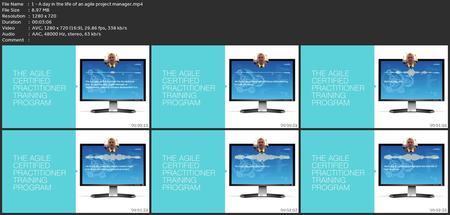Pmi-Acp Certification: Planning And Monitoring Iterations
MP4 | Video: h264, 1280x720 | Audio: AAC, 44.1 KHz
Language: English (US) | Size: 1.80 GB | Duration: 4h 18m
MP4 | Video: h264, 1280x720 | Audio: AAC, 44.1 KHz
Language: English (US) | Size: 1.80 GB | Duration: 4h 18m
Agile Certified Practitioner Certification Program - Course 5 of 8 - Planning and Monitoring Iterations
What you'll learn
Understand activities that take place during an iteration planning meeting, identify the outputs of the iteration planning meeting
Recognize the steps for creating an iteration backlog, calculate the buffer for a given set of project tasks, and pinpoint the appropriate actions to take
Recognize the tools are used to monitor progress during an iteration
Identify project information that should be updated in a release plan, and interpret project release information using various types of charts.
Requirements
Useful but not compulsory to study before - Course 1: Agile Project Management Essentials, Course 2 - Adopting an Agile Approach, Course 3 - The Scrum Development Process and Course 4 - Initiation and Requirements Gathering
Courses under development - Course 6: Leading an Agile Team; Course 7: Managing Stakeholder Engagement on an Agile Project; Course 8: Ensuring Delivery of Value and Quality in Agile Projects
This is course 5 of 8 from the Agile Project Management - The PMI-ACP (Agile Certified Practitioner) Certification Program
Description
Planning and Monitoring Iterations on an Agile Project
Welcome! This is the fifth course out of eight of the Agile PMI-ACP (Agile Certified Practitioner) Certification Program. This part is on Planning and Monitoring Iterations on an Agile Project.
An iteration planning meeting
In an agile project, planning occurs before each iteration starts. An iteration planning meeting should typically last for one or two hours per week included in an iteration, and should include the product owner, agile project manager, or Scrum Master, and the development team.
During iteration planning, the participants adjust the priorities of user stories and estimate the development team's velocity. They then develop an iteration goal, select user stories, break the stories down into tasks, and estimate the tasks. The three key outputs of an iteration planning meeting are the iteration goal, an iteration backlog, and an iteration schedule.
Creating an iteration backlog
During iteration planning, an agile project team follows three steps to create an iteration backlog. First the team splits any overly large user stories into multiple, smaller stories. Each story should be independent, negotiable, valuable, estimable, small, and testable.
Next the team breaks each user story down into development tasks. Each task should be specific, measurable, achievable, relevant, and time-boxed. Finally the team estimates the effort required to complete each task, generally using ideal hours.
Calculating the buffer
To help ensure that an agile project will be completed on time, you can use various types of buffers – including feature, project, feeding, and resource buffers.
To calculate a suitable project buffer, you can use the critical chain method or the square root of the sum of the squares method. Alternatively, you can simply add average-case estimates for tasks or user stories and divide the result by two.
Complex projects
For large, complex projects, project leaders should facilitate iteration planning by using a rolling lookahead approach, making plans for the next few iterations at a time. They should also communicate conditions of satisfaction for user stories before the relevant iterations start, and establish feeding buffers between tasks that are critically dependent to absorb any delays.
Monitoring progress during an iteration
Monitoring progress in an agile project involves assessing the end results of iterations in terms of customers' requirements, rather than comparing planned and actual progress. On a daily basis, an agile team uses standup meetings to track its progress and any obstacles.
In addition, a team may use an iteration backlog, task board, and burn charts to track its progress during an iteration. Managers and other stakeholders may also track progress using a burnup chart.
Project information
Agile project release plans should be constantly updated to reflect the work completed in a project, changes to requirements and priorities, and any revised estimates. When updating release plans, you should monitor the team's velocity and the frequency of unfinished user stories.
You can monitor and report project progress at the release level using release burnup and burndown charts, parking lot charts, and defect reports.
This course has two main sections. After completing the first one, called Iterative Planning and Estimating, you will be able to:
understand activities that take place during an iteration planning meeting,
identify the outputs of the iteration planning meeting,
recognize the steps for creating an iteration backlog,
calculate the buffer for a given set of project tasks, and
pinpoint the appropriate actions to take when planning iterations for a complex project.
After completing the second section, called Monitoring and Reporting Project Work, you will be able to, you will be able to:
recognize the tools are used to monitor progress during an iteration,
identify project information that should be updated in a release plan, and
interpret project release information using various types of charts.
Who is your instructor?
My name is Sorin, and I will be your instructor. I am a trainer and project manager with more than 10 years of experience. Before Udemy, I trained hundreds of people in a classroom environment – civil servants, managers, project workers, aid workers and many more. And I managed projects in the fields of justice, corrections, regional development and human resources development.
How will you benefit?
This course is intended for project managers, program managers, or anyone who wants to efficiently participate in agile projects. It is aligned with the Agile Certified Practitioner exam objectives developed by the Project Management Institute® and Certified ScrumMaster learning objectives.
Training videos, examples, exercices and quizzes will help you learn all about the Planning and Monitoring Iterations on an Agile Project. And, if you take your time to go through all the learning materials this will entitle you to claim 5 PDU’s for the PMI certification exams and to maintain your PMI certification.
So, thank you for considering this course! Now, go ahead, and hit that "Take This Course" button. And, see you on the inside.
Who this course is for:
Intended for project managers, program managers, or anyone who wants to efficiently participate in agile projects.,Aligned with the Agile Certified Practitioner exam objectives developed by the Project Management Institute® and Certified ScrumMaster learning objectives,Will entitle you to claim 5 PDU’s for the PMI certification exams and to maintain your PMI certification





